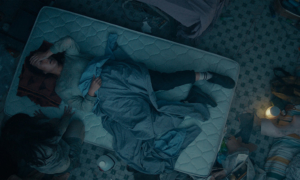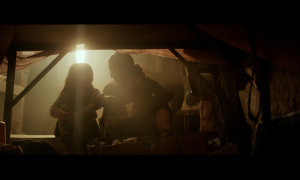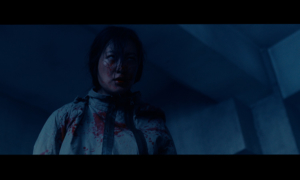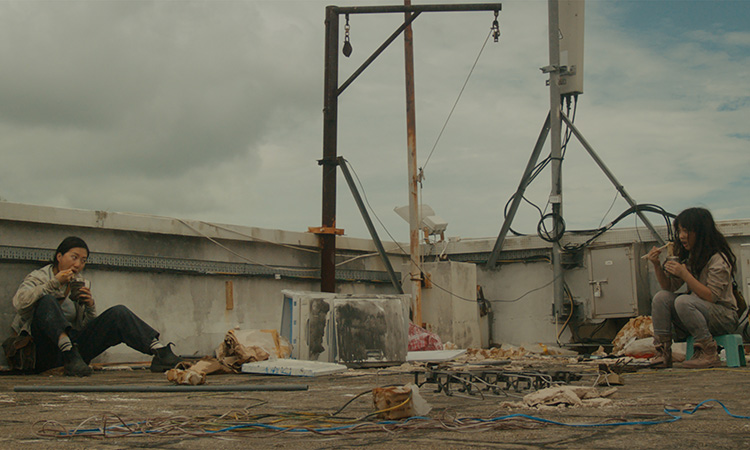Set in a post-apocalyptic world where a tsunami has destroyed Hong Kong, The Calm Beyond tells the story of Asha, who lives in a ruined building surrounded by water. With dangers all around her from scavengers, she lives hidden in plain sight, However, her concealed existence is changed forever when young Hei Hei literally floats into her life.
Written and directed by the late Joshua Wong, the movie stars Kara Wang as Asha, with Sarinna Boggs as young Hei Hei.
We spoke to Kara Wang about doing almost all of her own stunts and why she describes the movie as Castaway meets Waterworld…
How did you first get involved in The Calm Beyond?
I worked with the director Joshua Wong on a short film. Josh was really well known for short films – he’d done a bunch for Lucas Films and all of these great companies. I’d worked with him a couple of years back and we stayed in touch, we were always very friendly. I consider him such a dear friend of mine. He sent me the script and he was like: ‘I’m ready to shoot my first feature. Go ahead and give the script a read.’
So I picked it up and I just couldn’t put it down! It was just fascinating to me. It was such a great character development piece. I also knew that the script had come from his first experience with cancer, so I knew it was very, very personal. Then he was like ‘you want to do it?’ – yeah, I want to do it!
What were your first thoughts on the script?
I thought the story was very well written, even though it was very simple. When people ask me about it, I’m like – it’s like sci fi/apocalyptic, but also it’s like Castaway meets Waterworld. It’s a lot of these movies sort of mashed together.
Also, I was very excited to see a lead character written for an Asian female that was so nuanced, and so three dimensional and so complicated. She’s messy, she has layers and there’s so much depth to the character. That was something that I was really really excited to take on.
What else can you tell us about your character, Asha?
We’re with her current day, but we learn a lot as the story unravels about what happened to her through the flashbacks. You see her struggle with so many things when this little girl comes into her life because for so long her life has been stagnant. What is the difference between living and surviving? Those two things are very, very different. When that survival mechanism kicks in, sometimes it’s very easy to just coast and be content but there’s a difference between that and actually living. Living to your fullest potential, living your life and being happy. The themes of trauma and isolation are two really big themes that are present in the film.
It’s crazy because we shot this film pre-COVID. Now, two years later, here we are in a post/current COVID situation and I feel like audiences are going to be able to relate to this film like they might not have before. Trauma and isolation that now is a universal story that everybody in the world can relate to.
The timing of this film coming out is very interesting. Obviously when we shot it, we had no idea that this shitstorm was coming our way, but I know for Joshua it was so much about what we do with the calm after the storm. How do you pick up the pieces of your life after the storms have hit? And that is something that everybody is dealing with now…

How would you describe The Calm Beyond?
It is a disaster film. I would say it definitely has apocalyptic themes in there about what could happen if we don’t take care of our world properly.
But more than that, I describe it as a deep character development film as well, because at the end of the day the story is focused on this character’s story and this character’s arc and this character’s development. So it’s very rich in that story. With a little Mad Max in thrown there…
How would you describe the post-apocalyptic world The Calm Beyond is set in?
I would describe it as: anything goes. It goes back to our most primal needs as humans and our primal need to survive. [There is a] Mad Max part to it where there are human scavengers and humans who have turned the other way, delving maybe into the worst parts of themselves, but arguably, this is what they’ve had to do to band together to survive. Yes, the ugliest parts of humankind come out, but also the best parts can come out as well.
The rules of this world are there really are no rules. Everybody’s just trying to make it and everybody’s trying to survive and people do what they have to do. For Asha, she has also done that, in her world, the world that she’s built. She’s understood that there are dangers out there, and instead of venturing out and seeing if there’s hope, she’s chosen to isolate and take care of herself in that way, with no end in sight, which is disrupted when Hei Hei comes into her life.
How would you describe the relationship between Asha and Hei Hei?
Hei Hei kind of just floats into Asha’s life! Asha physically saves her, but I think it’s very clear as the movie goes on that it’s actually, in so many ways, the other way around. That Hei Hei has forced Asha to confront her trauma. All of the things that she has not been able to come to terms with. In so many ways Hei Hei has brought Asha back to life. She’s given her a reason to start living again and feel purpose. To come out of that survival mode and actually want to fight for her own life and fight for this little girl’s life. It’s like a second chance.

How much of the movie was shot in person?
So much of the film was shot in person! There was obviously some incredible CGI that they put in after and Joshua had such a great eye for CGI in that world – a lot of his previous works were mostly sci-fi, if not all sci-fi. But we had incredible production designers, set designers and art directors in Hong Kong. I think almost the entire crew was Hong Kong local, and they built the most incredible set from the ground up in a warehouse.
The apartment building where Asha lives was all built from the ground up, and those scenes where I was submerged in water… I mean, the logistics of it! I’m sure they had to seal off the room and put in the water and make sure it wasn’t leaking anywhere.
But filming it was great. I was in Hong Kong for a little over a month, and we shot everything there. We shot all the roof scenes up there as well. It was a really great experience. It felt like not that much acting was involved because sometimes I was like ‘this is rough!’. I’m submerged in water for 12 hours and on the roof and it’s pouring rain and I’m struggling!
You have a few action-packed scenes in The Calm Beyond, did you do much stunt training?
We had an incredible stunt team headed by Jason Li. Me and Joshua discussed me doing my own stunts for this film, but they did have a stunt double there just in case, for anything too aggressive and to make sure you’re staying safe.
So I did go through a little bit of training with Jason to make sure I was falling correctly and make sure that I was keeping my body safe. I would say for the most part I did I think close to 100% of my own stunts for the whole film. It was a great experience because I haven’t had the opportunity to do that yet. Everything was highly choreographed and it was very, very fun. Watching it back, I was like ‘that looks pretty real!’. It was a cool experience.

What were the biggest challenges you faced while shooting?
I would definitely say that the biggest challenges I faced were more internal and mental and emotional. The physical parts were challenging, but I was surrounded by so many amazing cast and crew that I really felt supported and I felt so safe. It wasn’t as hard as I expected it to be.
So I think the character development bit of this film with Asha [was the most challenging] because I know how personal this experience was to Josh. I just really wanted to do it justice. So there were a lot of conversations with him about why he wrote this character the way he did and the arc of that experience of being alone for so long and then the choices that she has made as Hei Hei comes into her life. There was a lot of work done at home after I would wrap and prep for the next scene the next day. I just wanted to make sure that I was doing the story justice.
How do you prep for those big emotional scenes?
I’m definitely somebody who cannot overthink or overanalyze things because I feel like sometimes if I work on it too much, it can be a little bit over-rehearsed. The truth is that for a lot of those emotional scenes, there’s only so much you can prep for it truly. There’s only so much you can rehearse for it.
In the moment, you just have to trust that you’ve done the work and just to pull from different aspects of my life or things that my friends have gone through and to try and parlay that into my work.
What do you want audiences to take away from The Calm Beyond?
I would love for audiences to feel that there is hope at the end of the day. Things will pass and there are always different choices and options that we can make in our lives for ourselves.
I know that the film is very bleak but I do think that the message at the end of the film is that there are storms in our lives, but there is the calm beyond.
The Calm Beyond is available to Download & Keep and to Rent on Digital now from Sony Pictures Home Entertainment
